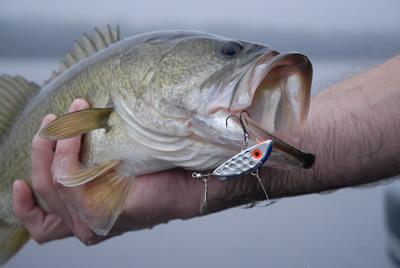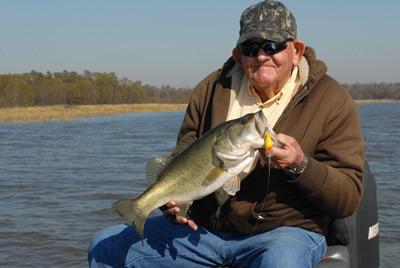Cooling water temps, changing seasons put bass in the mood to chomp

September 30, 2017 - You can always tell when fall hunting seasons begin inching closer in eastern Texas. One of the tell-tale signs is a obvious reduction in traffic around boat ramps at area bass lakes. Even the best lakes tend to see see fewer customers during fall as armies of bass anglers begin swapping their flipping' sticks and topwater outfits for scatterguns, deer rifles and archery gear.
That's not necessarily a bad thing, particularly for die-hard bass guys like my good friend Billy Rogers.
 Rogers is an 84-year-old bass nut from Nacogdoches who has never been one to get excited about a whole lot. But make one mention of deer season and you'll see a sudden twinkle in his eye, sort of like a kid who has been offered free rein in a candy store.
Rogers is an 84-year-old bass nut from Nacogdoches who has never been one to get excited about a whole lot. But make one mention of deer season and you'll see a sudden twinkle in his eye, sort of like a kid who has been offered free rein in a candy store.
That's interesting, because Rogers hasn't taken a seat in a deer blind in years. To hear him tell it, he stays way too busy chasing thick-shouldered bass during fall to waste time fooling around with unpredictable whitetail bucks.
"I love it when deer season rolls around," Rogers said with an impish grin. "A lot of the guys who bass fish start thinking about deer hunting during the fall. Some of them give it up altogether and may not go back to the lake or wet a hook until next spring. That's fine by me."
The way Rogers sees it, the less boat traffic there is on the lake the fewer the hooks that will be in the water. That means more unmolested bass for him to catch.
"I've seen quite a few days during fall when my truck was the only one in the parking lot," he said.
Highs and Lows of Fall
Rogers' attraction to autumn bass fishing is based on much more than a lack of company on the water.
Fall, which officially got underway on Sept. 22, is the harbinger of shorter days, longer nights and frequent cold fronts that typically increase with intensity each time a weather system comes rolling in. This results in a gradual decrease in water temperature that won't begin to reverse itself until next spring.
Another common sign of fall is low water levels. In a normal year, water levels on most reservoirs are well below full pool as the result of hot summer weather, day-to-day evaporation, daily water usage and minimal rainfall to replace what is taken out.
The low water pushes bass off of shallow flats and concentrates them along the edges of creek channels, river channels and other structure that provides easy access to the security of deep water. This narrows the size of the playing field and offers a pretty good hint as to where anglers might begin searching for fish, and which tactics should work best for exploiting them.
Of course, anybody who has spent much time around East Texas lately knows we're coming off a summer that was anything but normal as far as the weather goes. Hurricane Harvey saw to that, and water levels on many lakes in southeast Texas are well above normal for this time of year because of it.
Shad On the Move
The changing seasons and cooling water puts bait fish on the move and bass are quick to follow.
Threadfin shad are filter feeders by nature. Studies on shad movements indicate the succulent forage fish gravitate towards shallow water during fall, usually via creeks, drains and ditches that connect skinny water to deep. Take a look around in late September and October you should see pods of shad dimpling the surface in the mouths coves and major and secondary creeks.
The gradual influx of forage sometimes sparks some big time feeding binges that can play right into the hands of bass anglers who know what to look for and which cards to play when opportunities are golden.
Bottomline: Fall fishing in Texas can be pretty darned at times. Here are some fishing tips that might help turn an otherwise average day of autumn fishing into a banner one:
Up A Creek
If there is one time of the year that it doesn't hurt to be up a creek without a paddle, it's fall. Channels also act as highways for shad and other forage. By concentrating your efforts to channels you are sure to boost your chances of finding and catching fish.
Dissecting a Creek
Fall bass won't be everywhere along an underwater channel. Instead, they are usually found in relatively small areas, often in big numbers.
Locating theses "magic stretches" is a process of elimination that takes time to accomplish, but there are some things you can do to speed up the process.
* Location, Location: The upper 2/3 portion of a creek will usually be the most productive by the time October rolls around. Most pros say it's best to start at the back and fish your way out. If water levels are low it should make the channel fairly easy to follow, especially if there is grass or stumps lining the edges.
* Homing in on Hotspots: While fall bass are apt to be gather anywhere along a creek, they are prone to gravitate to places that offer something different from the surrounding area. Well-defined bends are always worth a look, as are other "oddities" such as slight indentions in a straightaway of grass, points of grass, a place where two creeks intersect or stick-ups/laydowns lodged on the creek bank.
Wakes, Boils and Birds
Perhaps the most obvious sign of a productive area are fish actually feeding. Keep an eye peeled for wakes and boils on the surface.
Another good visual aid to key is birds, especially blue herons. The big birds will often take a ringside seat when bass are feeding and pick off stray or wounded shad driven to the surface. If you see a heron perched on a stump adjacent to a channel, and the bird appears to be on point, it would be wise to move in and check it out.
Keep Your Distance
Let's say your are easing down channel and a well placed cast to a definitive creek bend or indention in a grass bed produces a fish. It would be wise hold off a ways and and work the area thoroughly from a distance. Remember, fall bass often run in gangs. Move too close and you could booger the spot prematurely.
Boat Position
When fishing a creek, try to keep the boat positioned on the middle of the channel. This will allow you to work both sides effectively. If you come upon a stretch that looks especially good, position the boat so you can cast parallel to the grass line, lay down or whatever it is that you suspect may be holding fish. This will allow you to keep the bait in the strike zone for the longest period of time.
Back to School Bass
As earlier mentioned, fall bass often run in gangs or schools. At times the fish will drive pods of shad to the surface or pin them against a shoreline so they can feed on them at will.
Schoolies are often so aggressive they will pounce on just about anything you throw at them, but certain baits tend to produce better than others.
Topwater baits like a Pop-R, Yellow Magic, Tiny Torpedo and Cordell Near Nuthin' (if you can find one) are veterans on the list. Other favorites are lipless crankbaits, square bill crank baits, buzz baits and small spoons.
When School Lets Out
Just because surface schooling wanes doesn't always mean the bite has died, or that the fish have left the area. They could be suspended just beneath the surface, waiting for another unsuspecting pod of shad to come swimming by. This is when a Texas rig worm matched with a light slip sinker, diving plug or the Alabama rig can pay off.
Match the Hatch
It is always a good idea to use baits and bait colors that simulate what bass are feeding on. During fall, that would be shad on most Texas lakes.
The best hard bait colors to throw now are Tennessee shad, chrome/blue, chrome/black, clear or bone.
Bait size also can make a big difference at times. For best results, try to use a lure that is fairly close to the same size as the forage on which the fish are feeding.
Waking the Blade
A spinnerbait can be deadly medicine during fall. The trusty blade comes through shallow cover extremely well and it does a good job of simulating fleeing bait fish.
Spinnerbaits can be fished in a variety of ways and at varied speeds. A good retrieve to try during the fall is a fast or "waking" retrieve, especially when fishing in relation to scattered clumps of aquatic vegetation or around lay down logs or bushes. The idea is to keep the bait moving at a rate of speed fast enough that it bulges or wakes the surface without actually breaking through. The speedy retrieve sometimes triggers bass to pounce on the bait without taking time to evaluate it. This is sometimes called a "reaction strike."
Offshore Options
As productive as creek fishing can be, offshore structure on many lakes will continue to hold big numbers of fish right on through fall. Humps, channel ledges, points and ridges are good places to look, particularly if the bottom is hard.
Assorted baits will get you bit out there. A shaky head, Carolina rig or spoon can be hard to beat. The trick is to use your electronics to graph structure to determine if fish are present. If so, pop a waypoint or drop a buoy to mark the spot for easy reference and have fun.
There's nothing more fun than whackin' 'em when there is nobody else around.
Matt Williams is a freelance writer based in Nacogdoches. He can be reached by e-mail, mattwillwrite4u@yahoo.com.









